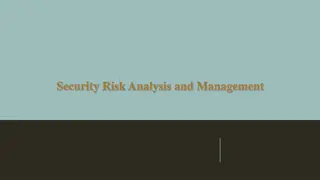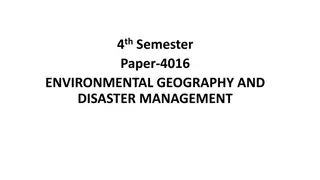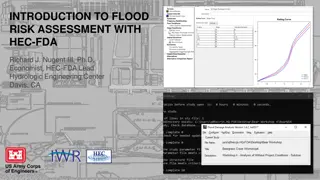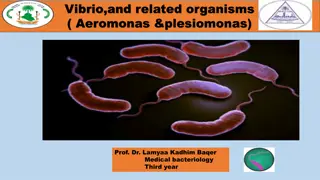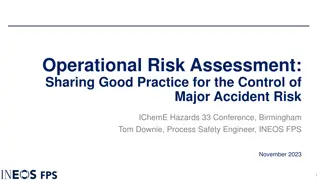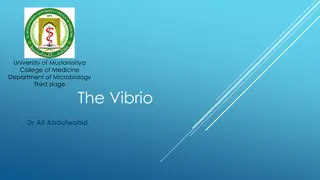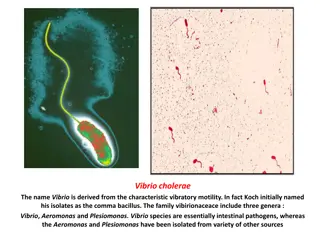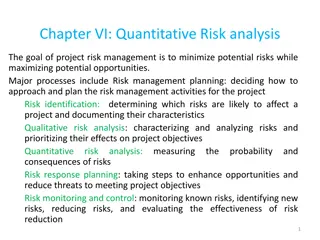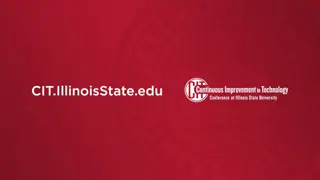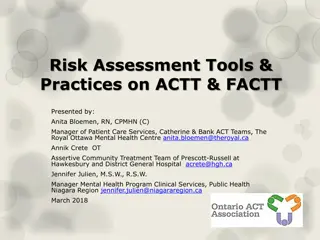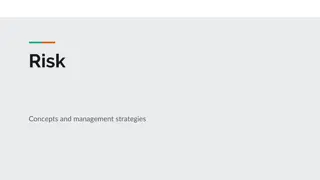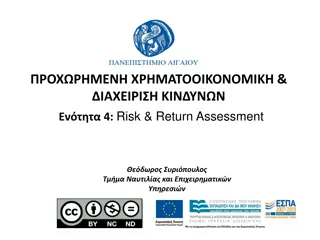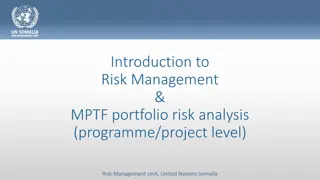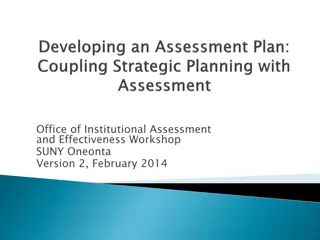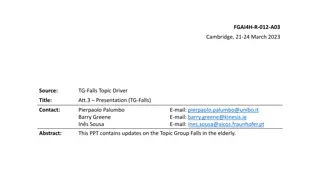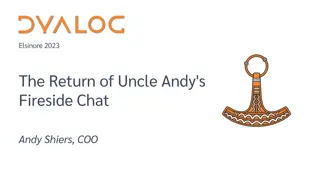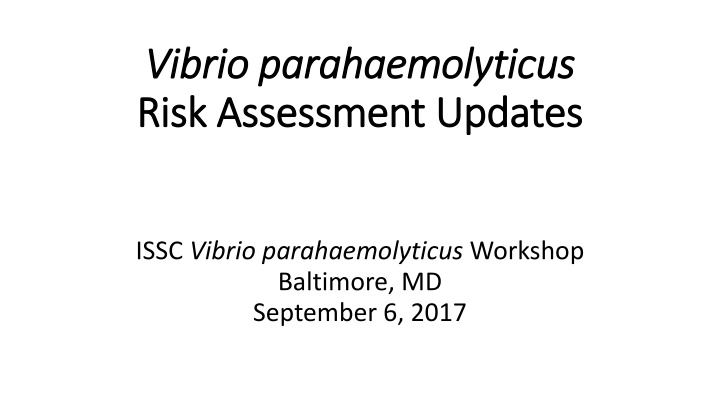
Updates and Insights on Vibrio parahaemolyticus Risk Assessment Workshops
Discover the latest findings and discussions from the FAO/WHO Working Group workshops focusing on Vibrio parahaemolyticus risk assessment, epidemiology, and management strategies. Key topics include exposure models for bivalve mollusks, water temperature effects, regional variability, and emerging risk management tools. Explore the implications for shellfish safety and future research directions.
Download Presentation

Please find below an Image/Link to download the presentation.
The content on the website is provided AS IS for your information and personal use only. It may not be sold, licensed, or shared on other websites without obtaining consent from the author. If you encounter any issues during the download, it is possible that the publisher has removed the file from their server.
You are allowed to download the files provided on this website for personal or commercial use, subject to the condition that they are used lawfully. All files are the property of their respective owners.
The content on the website is provided AS IS for your information and personal use only. It may not be sold, licensed, or shared on other websites without obtaining consent from the author.
E N D
Presentation Transcript
Vibrio parahaemolyticus Vibrio parahaemolyticus Risk Assessment Updates Risk Assessment Updates ISSC Vibrio parahaemolyticus Workshop Baltimore, MD September 6, 2017
FAO/WHO Working Group FAO/WHO Working Group Lead: Angelo DePaola FAO: Sarah Cahill, Iddya Karunsagar WHO: Rei Nakagawa Team US: John Bowers, Narjol Gonzalez-Escalona, Kristin DeRosia-Banick, Chris Schillaci Canada: Enrico Buenaventura Chile: Viviana Cachicas UK/Spain: Jaime Martinez-Urtaza Japan: Mitsuaki Nishibuchi New Zealand: Dorothy-Jean McCoubrey
Scope of FAO/WHO Work Scope of FAO/WHO Work Update vibrio epidemiology and risk management controls ISSC Canada States (CT, NY, MA, WA, Gulf) Other countries Assess skill of vibrio risk models for bivalve mollusks (examples) Exposure Risk characterization Emerging risk management tools Recommendations for future work
Are exposure models skilled for Vp and Are exposure models skilled for Vp and Vv mollusks? mollusks? Vv in bivalve in bivalve Water temperature influence Post-harvest growth rate Regional variability Seasonal variability Year to year variability Shellfish species Issues/Artifacts
Effect of water temperature on Effect of water temperature on V. parahaemolyticus parahaemolyticus levels in Mississippi oysters levels in Mississippi oysters V. Johnson et al 2010 VPQRA: red dashed lines MS observations: black circles/line Observed data slightly higher than VPQRA Possible artifacts VPQRA: No MS data 9/70 non-detects plotted at LOD Direct plating DNA probe
Influence of water temperature on Influence of water temperature on V. parahaemolyticus parahaemolyticus levels in Chesapeake Bay (MD) levels in Chesapeake Bay (MD) oysters oysters V. Parveen et al 2009 VPQRA: Red dashed line MD Observations: black circles/line Observed values less influenced by water temperature and greater than VPQRA especially at lower temperatures Issues/artifacts Non-detect plotted at LOD MD data not in VPQRA
Vibrio levels in Oysters & Clams Vibrio levels in Oysters & Clams Jones et al 2014 AEM Paired sampling C. virginica (A) M. mercenaria (B) Long Island Sound 2012-13 Vc, Vp and Vv harvest levels ~ 1 log higher in oysters than clams Issues/artifacts Relatively few samples Single estuary
V. parahaemolyticus V. parahaemolyticus growth in various regions, growth in various regions, seasons, years and shellfish species seasons, years and shellfish species
Vp Exposure Between USA Coastal Regions Not Vp Exposure Between USA Coastal Regions Not Predictive of Risk Predictive of Risk
Seasonal Vp Exposure Predictive of Risk Within Seasonal Vp Exposure Predictive of Risk Within US Coastal Regions US Coastal Regions
Table 1. Estimated Benefits of Rapid Cooling Vibrio Parahaemolyticus based on reported and laboratory confirmed illnesses without the adjustments for under-reporting or under- diagnosis. Region Reported Illnesses/year (Baseline 2008-2011) Predicted # of Reported Illnesses/year(Rapid Cooling) Predicted %- Reduction in Reported Illness Predicted Cost* of Reported Illness (Baseline) (Millions) Predicted Cost* of Reported Illness (Rapid Cooling) (Millions) 0.047 0.076 0.38 0.50 Atlantic Gulf PNW TOTAL *Cost per reported illness determined as $47,500 by combining Ralston s cost estimates for each of 3 illness severity classes (2=seek physician ($500), 3=hospitalization ($10,000), 4=death ($5,000,000)) with probabilities of each severity class among reported illnesses (2=seek physician (77.8%), 3=hospitalization (21.3%), 4=death (0.9%) as determined by Scallan et al. 20.1 16.4 131 167.5 1.0 1.6 7.9 10.5 95% 90% 94% 94% 0.95 0.78 6.22 7.95 11
Illness History in Connecticut: Illness History in Connecticut: 2009 to 2014 Illness Summary 2009 to 2014 Illness Summary Multi-State Including CT 2 2 2 3 11 2 Year 2009 2010 2011 2012 2013 2014 Confirmed CT Cases 1 1 1 1* 23** 1 *2012 Closure of Westport/Norwalk growing area from 7/15/12 through 9/19/12 ** 2013 Closure of Westport/Norwalk growing area from 8/2/13 through 9/16/13
Occurrence or introduction of outbreak strains Occurrence or introduction of outbreak strains drive risk drive risk TX 1998 - O3:K6 416 cases (98 culture confirmed) Few sporadic illness before and after 1998 Chile 2006-2008 03:K6 >10,000 Vp illnesses <100/yr since 2013 and most years since 2009 US NE Atlantic 2012-2013: O4:K12 >100 illnesses Unprecedented closures/recalls Few sporadic illnesses prior to 2012 O4:K12 remains dominant strain but rapid cooling reduced illness rates since 2014
Range expansion of outbreak strains due to warming of waters at higher latitudes represents greatest threat
Emerging technology capable of forecasting vibrio Emerging technology capable of forecasting vibrio levels and risk on global scale levels and risk on global scale https://coastalscience.noaa.gov/products/vibrioforecast/default User name: opcdata Password: M@rine2012! Vibrio doubling times Vp vs water temperature Other vibrio forecasting products
Emerging Pre Emerging Pre- -Harvest Purging Controls Harvest Purging Controls High salinity not effective for Vp purging Cold water transfer reduces Vp levels and risk AK lowered gear following 2004 outbreak Katama Bay, MA oysters transplanted in cooler Atlantic Ocean waters 2016 & 2017 Land base and off-shore work in Pacific NW British Columbia consistentlyreduces to <100/g Need greater reliance on guidance and less on Vp testing
Conclusions Conclusions Expanded body of knowledge relevant to vibrio risk model assumptions and predictions Application of vibrio risk assessment models for risk management in bivalve mollusks primarily in USA and Canada Exposure models demonstrate mixed skill due to high variability Vp and Vv levels in USA oysters Vibrio levels at harvest varies between shellfish species (e.g. oysters and clams) Post harvest vibrio growth varies between shellfish species (e.g. C. virginica, C. gigas, C. arikensis, Sydney rock oysters) Total and pathogenic Vp levels are not predictive of risk between different USA regions Seasonal level of total and pathogenic Vp are predictive within regions of USA Rapid cooling reduces Vp risk relative to vibrio growth models Occurrence or introduction of outbreak strains drive risk Range expansion of outbreak strains due to warming of waters at higher latitudes represents greatest threat Emerging pre-harvest mitigations capable of reducing vibrio exposure Emerging technology capable of forecasting vibrio levels and risk on global scale
Recommendations Recommendations Gather new data and conduct comprehensive analysis for regionalizing risk models Develop Vp dose response based on regional epidemiology similar to Vv dose response Support development of globally applicable risk assessment and management tools Climate/hydrography forecast models Regional risk models based on epidemiology Early recognition of introduction/emergence of highly infectious outbreak strains Develop BMPs corresponding and proportional to regional and seasonal risk Time temperature indicators to verify cold chain Develop outreach plan to demonstrate risk tools and adapt to local conditions of region


